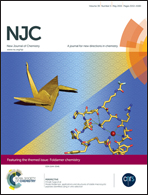Photocatalysis of Bi4NbO8Cl hierarchical nanostructure for degradation of dye under solar/UV irradiation
Abstract
Bi4NbO8Cl nanostructure has been synthesized from solution combustion synthesis. Morphology evaluated by scanning electron microscopy (SEM) showed rattle-shaped particles and nano-petals. Band gap measurements for the nanostructure and bulk-Bi4NbO8Cl were 3.4 eV and 2.6 eV, respectively. Photocatalytic activity was investigated for Bi4NbO8Cl nanostructure in comparison with bulk under UV and solar irradiation. Nano-Bi4NbO8Cl degraded Congo red faster than bulk under UV irradiation. However, despite having a wider band gap, the nanostructure showed similar photocatalytic performance to the bulk under solar irradiation. Mineralization of Congo red dye by nano-Bi4NbO8Cl demonstrated removal of 75.31% of the organic carbon in 80 min. Photoluminescence study revealed reduced recombination rate of electron–hole pairs for nano-Bi4NbO8Cl. A trapping experiment suggested that superoxide was the reactive species for the degradation of Congo red. The comparable photocatalytic performance in sunlight and reduced recombination rate can be attributed to the distinct morphology of nanostructure. The unique rattle shaped and nano-petal like nanostructure of hierarchical Bi4NbO8Cl offers design of layered material for generation of new and efficient photocatalysts.


 Please wait while we load your content...
Please wait while we load your content...